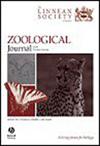中国中新世变形虫一新属及变形虫科系统发育的再考察
IF 2.8
2区 生物学
Q1 ZOOLOGY
引用次数: 0
摘要
阿米巴齿科是一群具有独特的铲状下颌联合和长牙的吻吻目动物,由于其形态特征不明确,一直是有争议的分类对象。我们构建了一个综合的特征矩阵的长链象形物种,并进行了分支分析,使用最简约的方法。我们的研究结果有力地支持变形虫科的单系性,但有必要进行分类修订。值得注意的是,我们提出了一个新的属,Saegusaia,用于以前归类为原楠科的中国标本,它代表了比非洲和南亚发现的真原楠科更基础的谱系。我们在阿米巴齿科中鉴定了两个单系亚科:Platybelodontinae和Amebelodontinae。巨齿龙和真齿龙,传统上被认为是缺乏下颌长牙的畸形齿龙,现在基于它们的颊齿与其他阿米巴齿龙的相似性被归入阿米巴齿亚科。此外,我们的重新评估表明,Konobelodon britti可能是Torynobelodon campester的初级同义词,仅限于北美。属于“Konobelodon”的欧亚形式是茎象,而不是阿米巴齿象科的成员。这些修订后的分类增强了我们对-阿米巴齿科和其他长吻象形动物的认识,突出了它们在更广泛的吻形动物进化背景下的重要性。它们代表了早期大象及其近亲多样化和适应的关键阶段。本文章由计算机程序翻译,如有差异,请以英文原文为准。
A new genus of amebelodonts from the Miocene of China and a re-examination of the phylogeny of the Amebelodontidae
Amebelodontidae, a group of proboscideans with distinctive shovel-like mandibular symphysis and tusks, have been the subject of contentious classification due to ambiguous morphological traits. We construct a comprehensive character matrix for longirostrine elephantiform species and conduct a cladistic analysis using the most-parsimonious approach. Our results strongly support the monophyly of Amebelodontidae but necessitate taxonomic revisions. Notably, we propose a new genus, Saegusaia, for Chinese specimens previously classified as Protanancus, which represent a more basal lineage than true Protanancus found in Africa and South Asia. We identify two monophyletic subfamilies within Amebelodontidae: Platybelodontinae and Amebelodontinae. Megabelodon and Eubelodon, traditionally considered aberrant gomphotheres lacking mandibular tusks, are now placed within the Amebelodontinae based on their cheek teeth similarity to other amebelodontines. Additionally, our re-evaluation suggests that Konobelodon britti may be a junior synonym of Torynobelodon campester, restricted to North America. Eurasian forms attributed to ‘Konobelodon’ are stem elephantoids rather than members of Amebelodontidae. These revised classifications enhance our understanding of Amebelodontidae and other longirostrine elephantiforms, highlighting their importance in the broader context of proboscidean evolution. They represent a critical stage in the diversification and adaptation of early elephants and their relatives.
求助全文
通过发布文献求助,成功后即可免费获取论文全文。
去求助
来源期刊
CiteScore
6.50
自引率
10.70%
发文量
116
审稿时长
6-12 weeks
期刊介绍:
The Zoological Journal of the Linnean Society publishes papers on systematic and evolutionary zoology and comparative, functional and other studies where relevant to these areas. Studies of extinct as well as living animals are included. Reviews are also published; these may be invited by the Editorial Board, but uninvited reviews may also be considered. The Zoological Journal also has a wide circulation amongst zoologists and although narrowly specialized papers are not excluded, potential authors should bear that readership in mind.

 求助内容:
求助内容: 应助结果提醒方式:
应助结果提醒方式:


